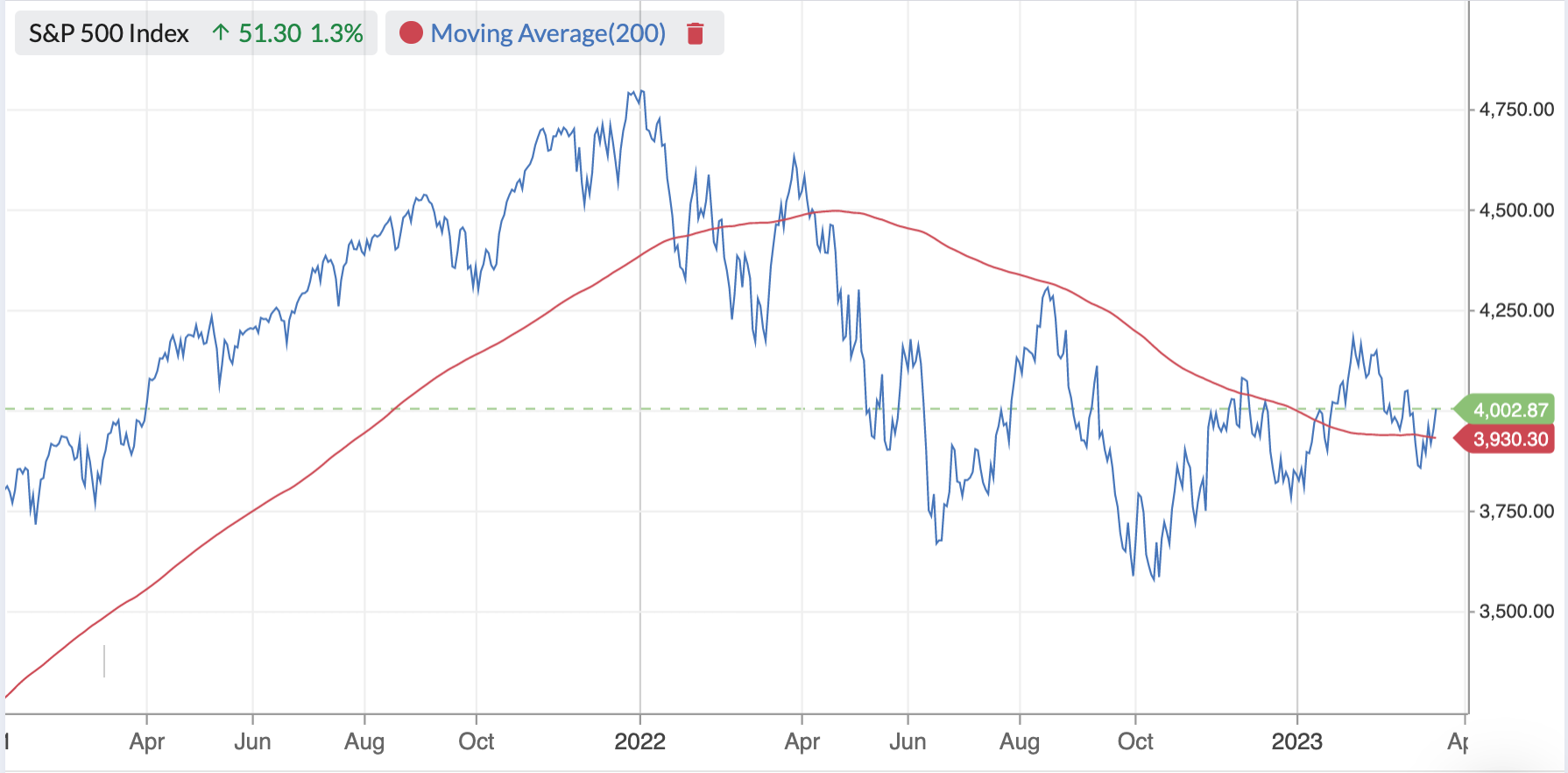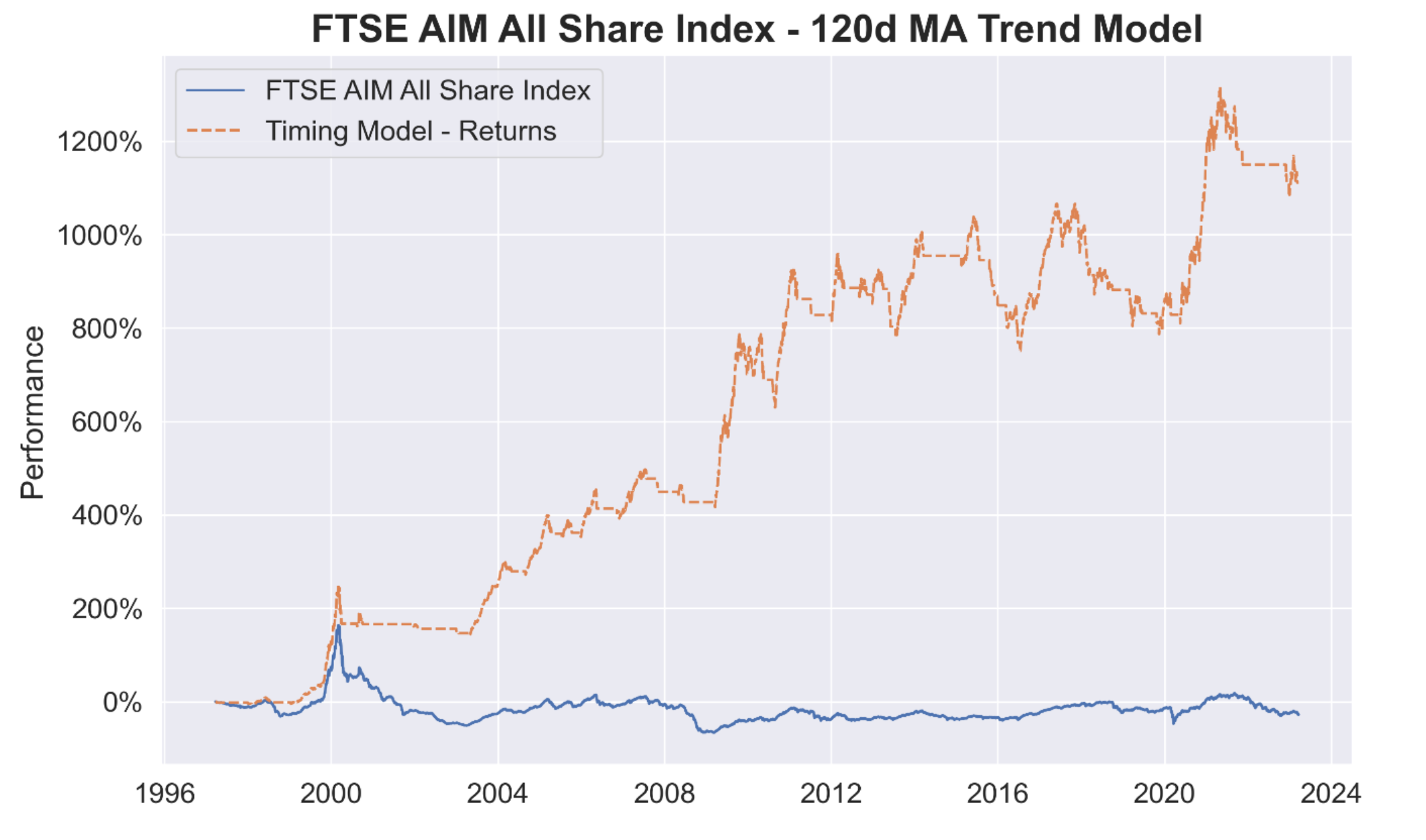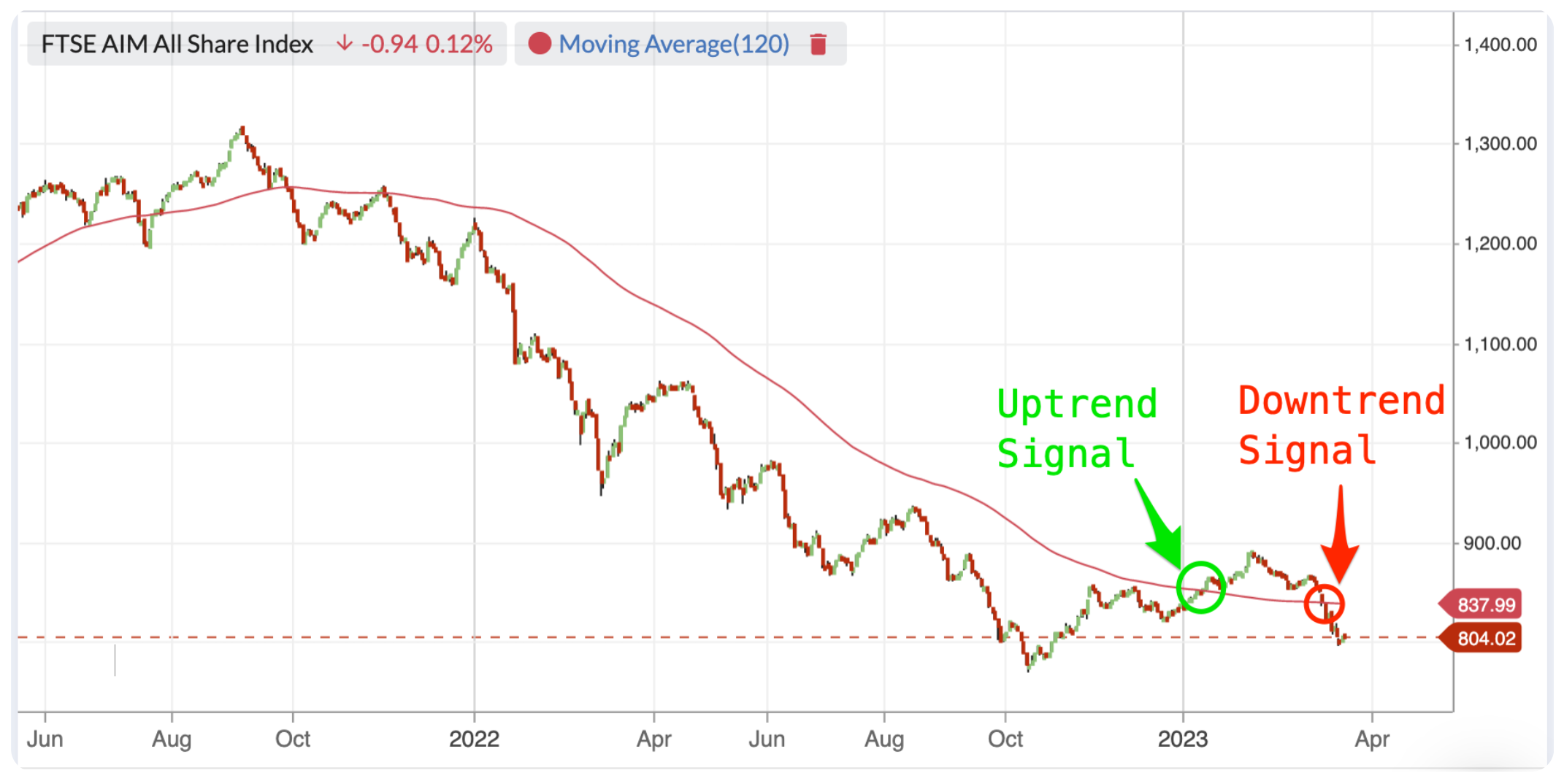Trend following the UK stock market - a timing signal update

With stock markets wobbly, it's a good moment to review the trend following model I've published occasionally over the last year. There is a well-known premise that asset prices have had a tendency to trend, and stock markets are no exception.
Brief primer on trend following
One of the simplest approaches to trend following is to compare the price of an asset (like the S&P 500) against its average price over a certain look back period. You buy the asset when the price moves above the average, and sell when it moves below. As prices change over time, the average is known as the moving average and can be plotted against the price in most chart packages, including ours.
Below shows the S&P 500 versus the 200-day moving average (200d MA).

There's been a great deal of research performed on the profitability of such an approach, with a particularly readable study by Meb Faber in "A Quantitative Approach to Tactical Asset Management".
He showed that in US markets between 1901 and 2012, buying the S&P 500 when it's above the 200d MA, and staying in cash when below both increases annualised returns (from 9.3% to 10.2%, and reduces downside volatility considerably (from 17.9% to 12.0%. Aside from these benefits, trend following reduces the maximum drawdown considerably (from 83% to 50%.
One great insight from Faber in a follow-up paper is that stock markets get far more volatile when they are below the 200-day moving average than when above. Not only this, but returns are lower too.
"On average, returns are 60% lower and the volatility 30% higher when the market is below 10-month simple moving average."
He reasons that humans use different parts of their brain when markets are downtrending than uptrending, which drives volatility in bear markets. Apparently, we use the same part of the brain that's stimulated by cocaine or morphine when markets are rising, but we use the flight response part of the brain when downtrending.
Applying trend following to individual shares
Of course, the above study was performed in the US and on a benchmark index - the S&P 500. Dealing in an index product like an S&P 500 ETF is pretty cheap, but if you are an investor directly investing in individual shares, then implementing a trend following system is trickier. The transaction costs of buying and selling individual shares based on the market index trend can eat you up. So what's the solution?
A good model is outlined in Andreas Clenow's excellent "Stocks on the Move". Clenow is a well-known investor, writer and pythonista. His book is a great read and recommended for any serious momentum investor's bookshelf.
He outlines an easily implemented approach that only deals on Wednesdays.
- He buys a portfolio of his highest-ranked momentum shares only when the overall market index is above its moving average.
- He uses some simple sell rules on the individual shares (if the share's rank falls below a cut-off, if the share falls below its own moving average, or if it has a 15% gap, he sells).
- If the overall market index drops below the moving average, he stops buying new positions. Cash is gradually raised when individual position sell rules are triggered.
- Cash is reinvested fully in new high ranked positions only when the index is above its moving average again.
Even without the market trend filter, the approach beats the S&P 500 handsomely 9.1% annualised return versus 5.2% return from 1999 to 2015 at lower risk), but with the market trend filter the strategy returns 12.4% annualised, with a maximum drawdown of only 24% versus 55% for the index.
A trend following rule of thumb
One of the great insights from Clenow's approach is that it provides a great rule of thumb for successfully navigating difficult stock markets.
Only buy new positions when the market is in an uptrend.
I know many on this site are bargain hunters, and downtrending markets serve up many bargains - so the above rule of thumb may not be popular. However, the maxim "don't try to catch a falling knife" is wise and worth remembering. Indeed, Meb Faber has shown that all stock market returns can be captured during uptrends, with lower volatility.
Discipline is everything.
Insights on the trend state of the UK stock market
One of the curious traits of the FTSE 100 is that it hasn't given good trend signals for decades. Trend following the FTSE 100 has been a fools errand - or at least has been for more than 30 years. The UK bellwether index is really a dividend machine, and trend followers should give it a wide berth - see my backtest below in orange.

But as mentioned on January 13th, the FTSE AIM All Share - which is the aggregate of the LSE's junior market stocks - is highly sentiment-driven and trends rather beautifully at times. As explained in the article, I prefer to use the 120-day moving average on this index. While the overall index has lost money over more than 25 years of history, the trend following model returned 50x over that time period, which drops to 12x when adding a 2% transaction cost drag.

Of course, in downtrending markets, the trend signals can get a bit choppy at times. After a bullish signal on January 12th, we've seen a bearish signal on March 13th.

Previous periods like this have seen choppiness in both directions, and of course, with all the banking shenanigans, there's downside volatility risk. The US Federal Reserve tends to increase and decrease rates until it breaks things, and rarely pivots dramatically until something goes horribly wrong. Yes, SVB, Signature Bank, First Republic and Credit Suisse are signs of things breaking, but deposits have been generally guaranteed. How long this approach holds out I don't know.
So, what am I doing? Well, I initiated a new family portfolio on January 16th, just after the uptrend signal, investing 1/3 of the capital in a set of 6 value/momentum names. They did rather well, increasing 12% by March 6th - mostly due to Yu (LON:YU.) and Kitwave (LON:KITW) . But those gains have now been given up, with the portfolio now flat. My pre-intention has been to invest another third after 3 months, but only if the market trend filter is in an uptrend. As per Clenow, Faber and my rule of thumb, I won't be initiating any new positions until it does so.

About Edward Croft
Co-founder and CEO here at Stockopedia.com. I was a wealth manager, then full-time private investor before setting up Stockopedia. I believe passionately in the power of data-driven investing to improve investment results. Oddly obsessed with the StockRanks.
Disclaimer - This is not financial advice. Our content is intended to be used and must be used for information and education purposes only. Please read our disclaimer and terms and conditions to understand our obligations.

Further to this - I actually got the frame of "Patience vs Bravery" from one of Andrew Lapthorne's classic pieces - he's Head of Quant at Soc Gen.
You may be able to access the PDF at this link
I talk the diagram through in the Screening Webinar - the overall webinar is quite introductory but you can probably skip forwards to 30:39 when I talk through this slide.
https://event.webinarjam.com/r...

And yet people do make money, I use a similar method based mainly on the MACD indicator, easy to implement and follow... following a rigid rule based system takes a lot of the psychological issues out of trading/investing... you just follow the rules, no second guessing. Such methods can take you out of the market when it's trading sideways (which markets can for long periods) this frees up money to invest elsewhere and can get you out of markets before a crash reducing draw down considerably, it can even give you an indication to short. It might not be pure "investing" and more like trading I suppose but you can do both (or have a hybrid) and profit from it. I've been thinking of adding in Stockopedia ranking values for a while, I've just got to figure out how to back test it.

With the S&P 200MA model is there mileage in placing a short until it rises above the 200MA. For example if you had a £200k pot, buy the S&P etf with pot, and if below short the S&P at £50 per point in a spread bet account (assuming S&P around 4000) or use other shorting vehicle. Funding costs may be high, but if in cash for 18 months waiting for rise there is an opportunity cost.
Greyster

Authors Richard Koch and Leo Gough discuss matching investing styles to personality quite extensively in their Financial Times guide Selecting Shares That Perform (10 ways to beat the stock market).
They write that investors can be divided into three personality types based on Professor Harold Leavitt’s study of human behaviour: the visionary, the analyst and the doer.
The book includes a personality test which determines which group you fall into and therefore which of the 10 investing styles best suit your personality.

Thank you Edward for an interesting read, I especially enjoyed the Match Style to Psychology diagram but I couldn't see Over Optimistic on it. I've caught so many falling knives it's a wonder I've any fingers left and I've risked two more fingers today by investing in Anpario and Eurocell. My ex-stockbroker friend said I was his reverse barometer on what he should be doing but I'm still hanging on in there, currently approx 50/50 cash/equities. Good luck with your family portfolio.

Ed, Thanks. I caught up on the webinar to see the link to psychology part. Very good!

Hi ed, Thank you for the absolutely amazing website Stockopedia. Would it be possible to have a UK Mid Cap value report like Paul's small cap one? A lot of reader wish to see this addition to stockopedia. Imagine how much this can attract people to stockopedia having a better liquidity in the mid cap with less risk like small cap and potential for multi bagging. Paul has kindly offered to cover some companies that are flagged by readers but, he barely can keep up with the small cap. If you can please have someone assigned to write about mid cap stocks, that will be amazing. Kind regards


Tell us more please Linney. My psychological issues are getting in the way of my returns but I can't shake old (bad) habits. I need some rules!


If you can sit there & wait for 6 months for a signal to enter the market,then it goes againt you,you then sell to find good news as arrived ,market bounces strongly,you then find yourself on the sidelines deflated wishing you had stayed in the market.you then after a couple of weeks of beating yourself up & fomo kicks in you decide to enter the market.Your feeling part of the action now, then bad news arrives ,market falls heavily you are now feeling a bit of a fool & a waste of space, you then panic & sell out, repeat & rince.This is a perfect market for those type of actions,volatile , poor liquidity, etc.Good luck to any one who can master timing.

You can buy shares when they break above a certain point, say 150 Day Moving Average, then hold unless they drop below it. If you had done that on Yu (LON:YU.) and various others even last year, you would have done quite well, plus you would have got some dividends. Sitting on cash with next to no interest and inflation at over 10% is difficult.

I'm very much in sympathy with most of this -- I also like Meb Faber and Andreas Clenow, and I'm also running a VM portfolio.
I just wonder if a simpler approach wouldn't be to run the VM portfolio without regard to market conditions, but to partially hedge market exposure by shorting relevant indices or ETFs in a spread-betting account when market conditions are inauspicious from a trend-following point of view. I don't do this myself, but I'm thinking maybe I should.
I know in theory it's less streamlined as an approach (why go long and short simultaneously when you can just be flat?), but I suspect in practice it's a more flexible approach, and probably easier psychologically.

Another great article. Love the Psychology Venn Diagram. Where can I find the AIM 120 day moving average most easily please? Thanks.

commenting so I remember to come back and view the webinar looks interesting !
*Past performance is no indicator of future performance. Performance returns are based on hypothetical scenarios and do not represent an actual investment.
This site cannot substitute for professional investment advice or independent factual verification. To use Stockopedia, you must accept our Terms of Use, Privacy and Disclaimer & FSG. All services are provided by Stockopedia Ltd, United Kingdom (company number 06367267). For Australian users: Stockopedia Ltd, ABN 39 757 874 670 is a Corporate Authorised Representative of Daylight Financial Group Pty Ltd ABN 77 633 984 773, AFSL 521404.



That's one of my creations from the recent screening webinar - I am going to write up a blog on this soon.